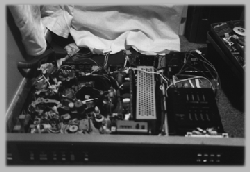Technical
The Deck and Heads
When a tape is inserted it is automatically loaded around the head. The video head itself is a 2-pin design and when replaced the new head requires eccentricity alignment. The Audio/Control head like the video head is the same as used the Sony SL-C5.The deck is a cut down version of that used in the C5. Not so many belts are employed in the NEC model. The capstan is powered by a DC motor and a belt is used to drive the flywheel, the head and the reel drive pulley. Pause is activated by a solenoid pushing back a level on the reel pulley. This makes the operation noisy but it is a smooth and quick action.
Rewind and Fast Forward are activated by a swinging pendulum idler again control via a solenoid.
The counter is belt driven from the take up spool.
The Tuner, Timer and clock
The tuner is a rotary dial type allowing 8 channels to be stored. The RF and tuner circuitry is mostly Sony based although does not look the same as the C5.
 The Clock module is a simple 4 digit display. It is NEC in origin but is exactly the same design
of tube used in the SLC-5.
The Clock module is a simple 4 digit display. It is NEC in origin but is exactly the same design
of tube used in the SLC-5.
Chroma and Audio Boards
These are NEC is design but employ mostly Sony components.Control features
The control logic is on the left of the power supply.There are separate pots to allow adjustment of picture search speed etc.Fault Guide
This is based upon the Sony SL-C5 pages.Tape transport is sluggish / fails to rewind
Internally the VCR contains many drive belts which are used in the mechanics of tape transport. With age these belts become slack causing malfunctions and when this happens the whole lot should be replaced. In particular for the rewind function you will need to replace a tyre on the supply reel.Strange behaviour of capstan/drum servo
The first thing to check is the tantalum capacitors in the servo circuit. Look for the 2.2 microfarad ones first.Sluggish threading and capstan problems
The bottom bearing on the capstan motor is prone to wear and because this motor also drives the threading mechanism threading can become sluggish. When this happens you will hear a horrible squeaking noise! It is possible to strip down the motor and replace the bearing but an easier option is to replace the entire motor if you can find a replacement.
Quick fault guide
Please click on the button if you are able to contribute a solution to this list or would like to add to, or update PALsite's information on this model. Please note, questions will be removed.If you have a question about this model, please raise it on the chatpage.
| Fault | Solution |
|---|---|
| No power, dead display, or unresponsive buttons | 1. Check the internal fuse. 2. Check the capacitors in the power supply. 3. Test the power switch and relays are working correctly. |
| Tape fails to load fully, gets stuck, or won't eject | The loading belts are probably worn or stretched. First try giving them a good clean and then if possible find replacement parts (possibly compatible with other models). Also ensure good lubrication on the loading parts. |
| Tape doesn't move, or only one reel turns | Motor brushes could be worn out. Also test that drive transistors or motor controlled ICs are working correctly. |
Many thanks to James Copp-Taylor for providing information and pictures of this model

